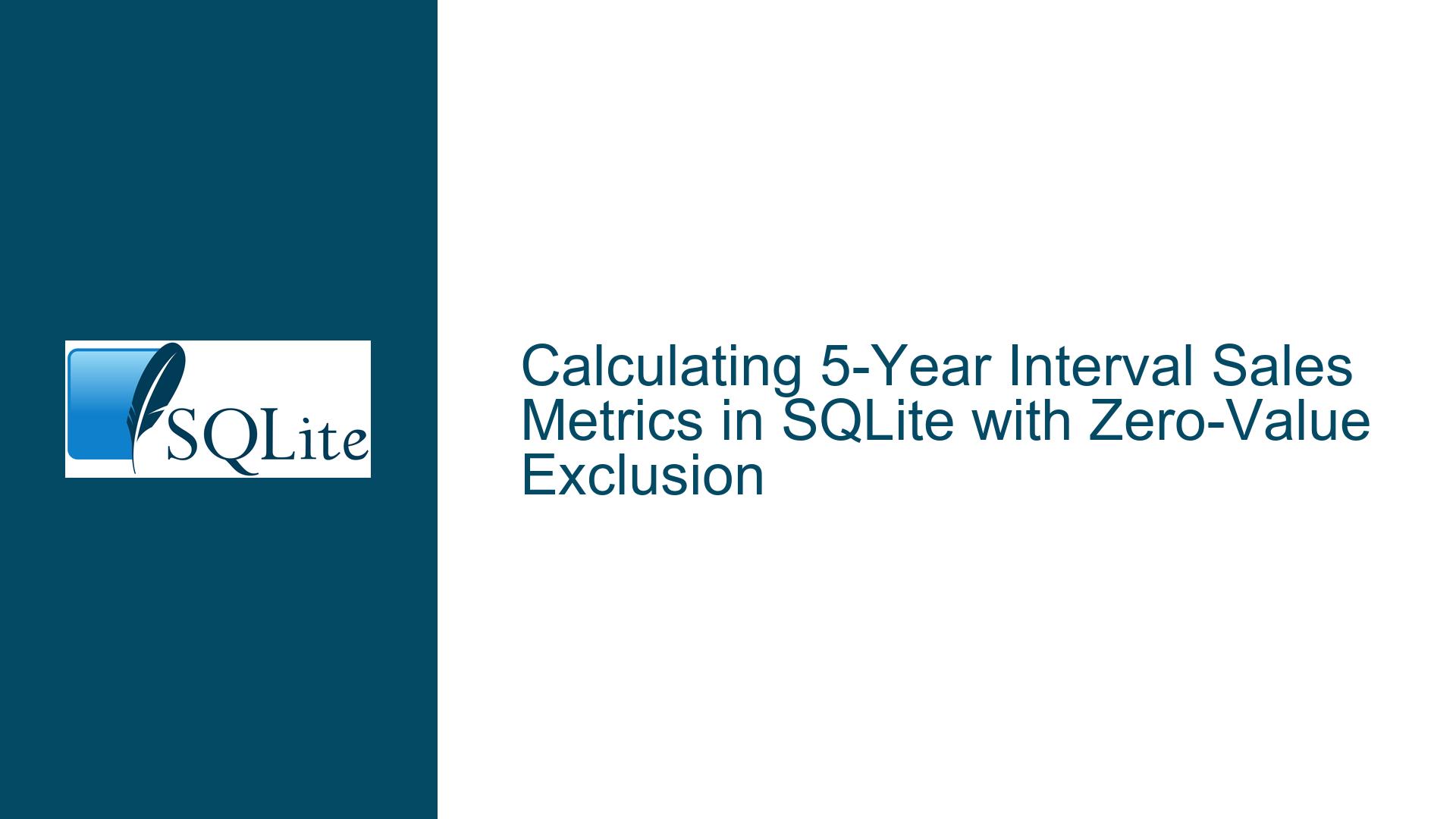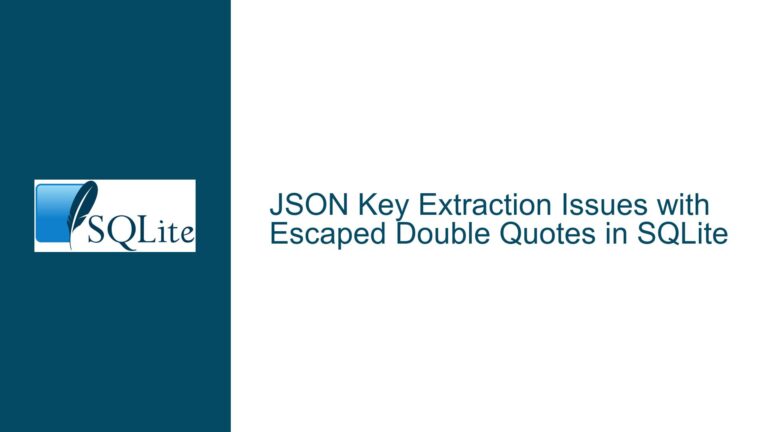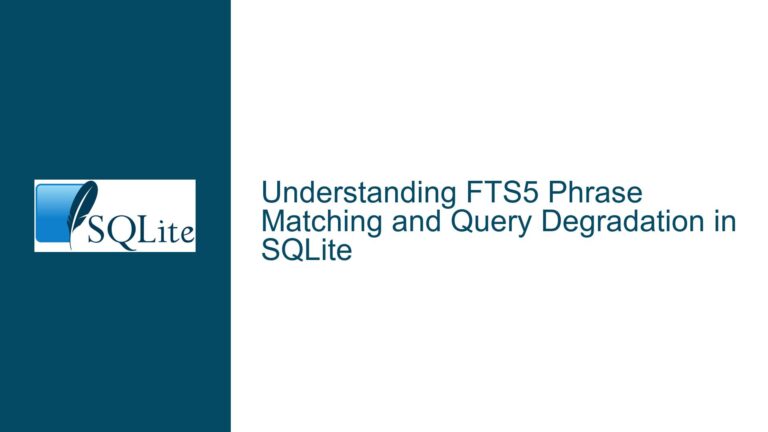Calculating 5-Year Interval Sales Metrics in SQLite with Zero-Value Exclusion
Handling Sales Data Aggregation Over 5-Year Intervals
When working with sales data spanning multiple years, a common requirement is to aggregate metrics such as average, minimum, and maximum sales over specific intervals. In this case, the interval is five years, and the challenge is to exclude zero values from the calculations. This scenario is particularly relevant for businesses analyzing product performance over time, where zero values might represent missing or irrelevant data.
The core issue revolves around constructing an SQL query that can:
- Group sales data by product and a 5-year interval.
- Calculate the average, minimum, and maximum sales for each interval.
- Exclude zero values from the calculations to ensure accuracy.
To achieve this, we need to understand the structure of the data, define what constitutes a 5-year interval, and implement SQL logic to filter and aggregate the data appropriately. The following sections will explore the possible causes of confusion or errors in this process and provide detailed troubleshooting steps and solutions.
Misaligned Year Intervals and Zero-Value Handling
One of the primary challenges in this scenario is defining and aligning the 5-year intervals correctly. If the intervals are not properly defined, the aggregation will yield incorrect results. For example, if the intervals are misaligned, a year might be included in the wrong interval, leading to inaccurate calculations. Additionally, the presence of zero values in the dataset can skew the results, especially for average and minimum calculations.
Another potential issue is the lack of clarity in the dataset structure. Without a clear understanding of the table schema, it becomes difficult to write precise queries. For instance, if the year column is stored as text instead of an integer, comparisons and range filters might not work as expected. Similarly, if the sales column includes null values or non-numeric data, the aggregation functions might fail or produce incorrect results.
To address these issues, we need to ensure that the data is properly structured and that the intervals are clearly defined. We also need to implement logic to exclude zero values from the calculations. The following section will provide detailed steps to achieve this.
Implementing Interval-Based Aggregation with Zero-Value Exclusion
To solve the problem of calculating sales metrics over 5-year intervals while excluding zero values, we need to follow a systematic approach. This involves defining the intervals, filtering out zero values, and performing the necessary aggregations. Below is a step-by-step guide to achieving this in SQLite.
Step 1: Define the Table Structure and Data
First, ensure that the table structure is well-defined. The table should have columns for product, year, and sales. The year column should ideally be stored as an integer to facilitate range comparisons, and the sales column should be numeric to allow for aggregation functions.
CREATE TABLE sales (
product TEXT,
year INTEGER,
sales REAL
);
Insert sample data into the table. Make sure to include zero values and data spanning multiple 5-year intervals.
INSERT INTO sales VALUES ('A', 2000, 0); -- Excluded because zero
INSERT INTO sales VALUES ('A', 2001, 10);
INSERT INTO sales VALUES ('A', 2002, 20);
INSERT INTO sales VALUES ('A', 2003, 20); -- Excluded by year range
INSERT INTO sales VALUES ('B', 2000, 5);
INSERT INTO sales VALUES ('B', 2001, 10);
INSERT INTO sales VALUES ('B', 2002, 0); -- Excluded because zero
INSERT INTO sales VALUES ('B', 2003, 100); -- Excluded by year range
Step 2: Define the 5-Year Intervals
Next, define the 5-year intervals. For this example, let’s assume the intervals start at the year 2000. The intervals would then be 2000-2004, 2005-2009, 2010-2014, and so on. We can use a combination of arithmetic and SQL functions to group the data into these intervals.
SELECT
product,
(year / 5) * 5 AS interval_start,
((year / 5) * 5) + 4 AS interval_end,
sales
FROM sales
WHERE sales > 0;
This query calculates the start and end years of each 5-year interval and filters out zero values. The (year / 5) * 5 expression effectively rounds down the year to the nearest multiple of 5, which serves as the start of the interval.
Step 3: Aggregate Sales Data by Product and Interval
Now that we have defined the intervals and filtered out zero values, we can proceed to aggregate the sales data. We will use the GROUP BY clause to group the data by product and interval, and then calculate the average, minimum, and maximum sales for each group.
SELECT
product,
(year / 5) * 5 AS interval_start,
((year / 5) * 5) + 4 AS interval_end,
MIN(sales) AS min_sales,
AVG(sales) AS avg_sales,
MAX(sales) AS max_sales
FROM sales
WHERE sales > 0
GROUP BY product, interval_start;
This query groups the data by product and the start year of each interval, then calculates the minimum, average, and maximum sales for each group. The WHERE sales > 0 clause ensures that zero values are excluded from the calculations.
Step 4: Handle Edge Cases and Validate Results
Finally, it’s important to handle edge cases and validate the results. For example, if a product has no sales in a particular interval, it should not appear in the results for that interval. Additionally, ensure that the intervals are correctly aligned and that the calculations are accurate.
To validate the results, you can run the query on a sample dataset and manually verify the output. For instance, in the sample data provided earlier, the product ‘A’ should have the following metrics for the 2000-2004 interval:
- Minimum sales: 10
- Average sales: 15
- Maximum sales: 20
Similarly, product ‘B’ should have the following metrics for the same interval:
- Minimum sales: 5
- Average sales: 7.5
- Maximum sales: 10
If the results match the expected values, the query is functioning correctly. If not, revisit the query logic and ensure that the intervals and filters are correctly defined.
Step 5: Optimize the Query for Performance
For large datasets, the query performance might become a concern. To optimize the query, consider creating indexes on the year and sales columns. This will speed up the filtering and grouping operations.
CREATE INDEX idx_year ON sales(year);
CREATE INDEX idx_sales ON sales(sales);
Additionally, if the dataset is extremely large, you might want to consider partitioning the data by year or product to further improve performance.
Step 6: Automate the Reporting Process
If this type of report is needed frequently, consider automating the process. You can create a stored procedure or a script that generates the report and exports it to a file or sends it via email. This will save time and ensure consistency in the reporting process.
-- Example of a stored procedure to generate the report
CREATE PROCEDURE GenerateSalesReport()
BEGIN
SELECT
product,
(year / 5) * 5 AS interval_start,
((year / 5) * 5) + 4 AS interval_end,
MIN(sales) AS min_sales,
AVG(sales) AS avg_sales,
MAX(sales) AS max_sales
FROM sales
WHERE sales > 0
GROUP BY product, interval_start;
END;
You can then call this procedure whenever you need to generate the report.
CALL GenerateSalesReport();
Conclusion
Calculating sales metrics over 5-year intervals while excluding zero values is a common but complex task in SQLite. By following the steps outlined above, you can ensure that your queries are accurate, efficient, and scalable. Properly defining the intervals, filtering out zero values, and validating the results are key to achieving the desired outcome. Additionally, optimizing the query and automating the reporting process can save time and improve productivity in the long run.
By addressing these issues systematically, you can handle similar data aggregation challenges with confidence and precision. Whether you’re working with sales data, financial records, or any other time-series data, the principles outlined in this guide will help you achieve accurate and meaningful results.






